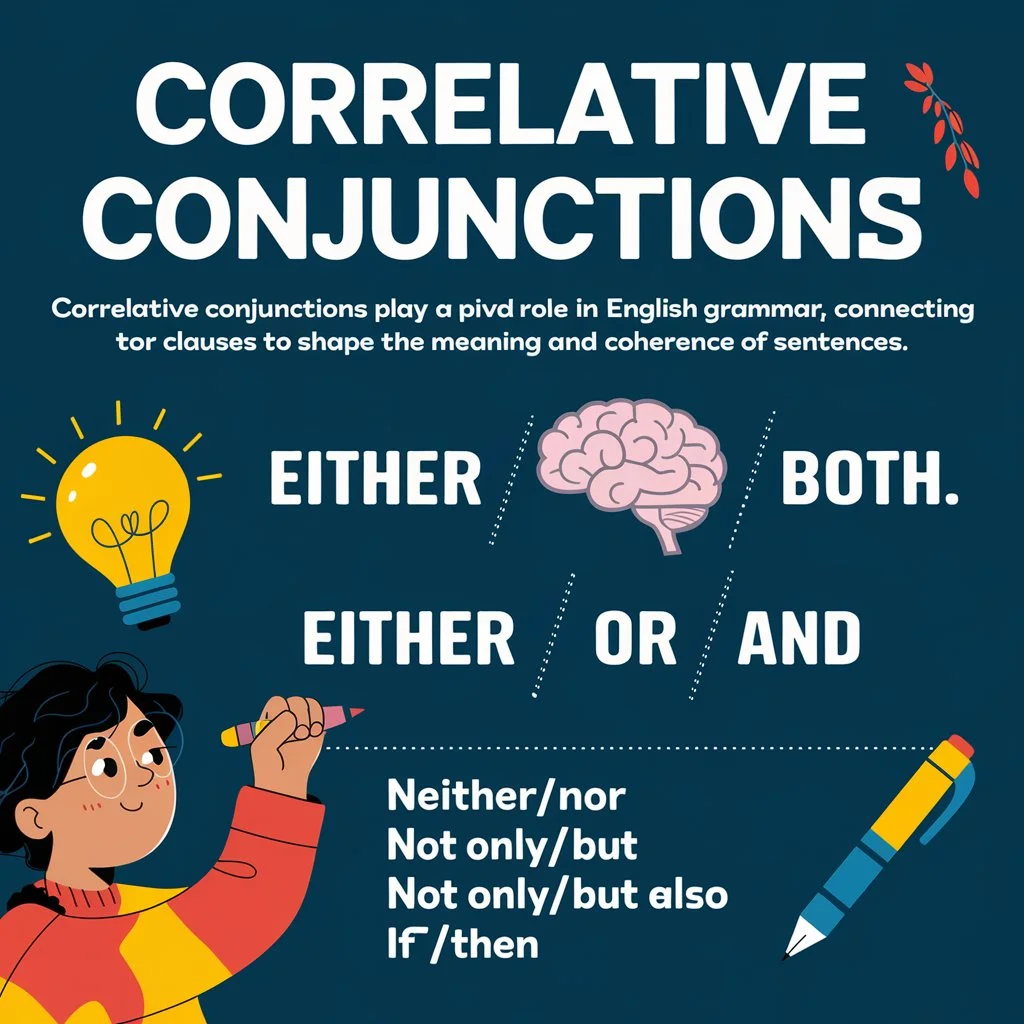Correlative conjunctions play a pivotal role in English grammar, connecting phrases or clauses to shape the meaning and coherence of sentences. These dynamic word pairs, such as “either/or” and “both/and,” work together to link ideas seamlessly. By providing alternatives, showing relationships, and emphasizing parallel structures, correlative conjunctions enhance the clarity and impact of our communication.
Their unique ability to balance different parts of a sentence ensures that each element carries equal weight and importance. In this article, we will delve into the world of correlative conjunctions, exploring their functions, examples, and practical usage to better understand how they create cohesive and effective sentences.
What are Correlative Conjunctions?
Correlative conjunctions are pairs of words used to connect similar elements within a sentence. They work in pairs to link words, phrases, or clauses that carry equal weight or importance in a sentence. Some common correlative conjunction pairs include:
- Both…and
- Either…or
- Neither…nor
- Not only…but also
- Whether…or
Function of Correlative Conjunctions
Correlative conjunctions, unlike single-word conjunctions such as “and,” “but,” or “or,” operate in pairs, forming a unique bond that influences the structure and meaning of sentences. They consist of two words that work jointly to connect similar elements within a sentence, emphasizing a sense of balance and correlation between these elements.
What distinguishes correlative conjunctions is their versatility in expressing various relationships within a sentence. They not only present alternatives but also establish connections between ideas, showcase contrasts, and emphasize parallel structures. These pairs work in harmony to create cohesive and impactful sentences by maintaining a balance between different parts of speech.
For instance:
- “Either/or”: This pair presents a choice between two alternatives, showcasing the mutual exclusivity of options. “You can either go to the party or stay home with me and relax.”
- “Neither/nor”: Denoting a negative correlation between two elements, this pair expresses the absence of both options. “Neither the book nor the movie was appealing to my son.”
- “Both/and”: This pair emphasizes inclusivity and the coexistence of two elements. “She is both diligent and compassionate.”
Correlative Conjunctions Examples
- “Either/Or: Specifies a choice between two alternatives.
- You can either stay at home or go out with friends.
- Either take the bus or walk to school.
- Neither/Nor: Represents the negation of both options.
- Neither the manager nor the employees were satisfied with the decision.
- She likes neither tea nor coffee.
- Both/And: Emphasizes the inclusion or coexistence of two elements.
- He is both intelligent and hardworking.
- The project was both challenging and rewarding.
- Not Only/But Also: Highlights a combination of elements or ideas, adding emphasis.
- She not only sings beautifully but also dances gracefully.
- The film was not only entertaining but also educational.
- Whether/Or: Presents possibilities or alternatives.
- We will go to the beach whether it rains or shines.
- Whether you agree or disagree, the policy will be implemented.
- Such/That: Shows the extent or consequence of something.
- It was such a hot day that we decided to stay indoors.
- She was such a good teacher that all her students passed the exam.
- As Many/As: Indicates an equal quantity or number.
- Bring as many books as you can carry.
- He invited as many friends as possible to the party.
- No Sooner/Than: Signifies an immediate sequence of events.
- No sooner had she left the house than it started raining.
- He had no sooner finished eating than he had to leave.
- Rather/Than: Introduces a preference or choice between alternatives.
- I would rather read a book than watch TV.
- She prefers to travel by train rather than by plane.
- Scarcely/When: Denotes that one event happens immediately after another.
- He had scarcely sat down when the phone rang.
- She had scarcely finished her work when her boss called her in.
- Either/Or:
- You can either pay with cash or use a credit card.
- Either the plan will work, or we need to find another solution.
- Neither/Nor:
- Neither the food nor the service was satisfactory.
- He likes neither hiking nor camping.
- Both/And:
- The course is both informative and engaging.
- They are both excellent athletes and dedicated students.
- Not Only/But Also:
- The team is not only hardworking but also very creative.
- The place is not only beautiful but also historical.
- Whether/Or:
- We need to know whether you will attend or not.
- She was unsure whether to laugh or cry.
Examples to Illustrate the Usage of Correlative Conjunctions
Let’s look at these conjunctions with some practical examples. These examples showcase how correlative conjunctions bring clarity and precision to sentences by expressing choices, exclusions, or mutual inclusiveness.
- Either eat pizza or go for sushi tonight.
- You have a choice: eat pizza or go for sushi tonight.
- Either the blue dress or the red one will suit the occasion.
- One of these dresses, either the blue or the red one, will be good for the occasion.
- Neither John nor Sarah could attend the meeting.
- Both John and Sarah were unable to go to the meeting.
- The package contains neither fruits nor vegetables.
- There are no fruits or vegetables in the package.
- He is both a doctor and a musician.
- He works as both a doctor and a musician.
- The novel is both thrilling and thought-provoking.
- The book is exciting and makes you think deeply.
- Not only did she finish the project, but she also presented it flawlessly.
- She not only completed the project but also showed it perfectly.
- The event was not only entertaining but also educational.
- The event was enjoyable and educational too.
- Whether it rains or shines, we’ll enjoy the picnic.
- We’ll have fun at the picnic regardless of whether it rains or the sun shines.
- He will attend the meeting whether he receives the invitation or not.
- He plans to go to the meeting regardless of getting an invitation.
- She was such a talented singer that the audience applauded for several minutes.
- She sang so well that the audience clapped for a long time.
- The car was in such bad condition that it was beyond repair.
- The car was so damaged that it couldn’t be fixed.
- He has invited as many friends as possible to the party.
- He asked many friends to come to the party.
- Please bring as many books as you can carry.
- Bring a lot of books if you’re able to carry them.
- No sooner had the meeting started than the fire alarm went off.
- The fire alarm went off right after the meeting began.
- She had no sooner arrived home than she received an urgent call.
- She got an urgent call immediately after reaching home.
- I would rather walk home than take a taxi.
- I prefer to walk home instead of using a taxi.
- He prefers to read rather than watch television.
- He likes reading more than watching TV.
- He had scarcely started reading when the power went out.
- He began reading, but the electricity stopped soon after.
- She had scarcely finished her breakfast when the phone rang.
- She almost finished eating breakfast when the phone rang.
Correlative Conjunction Exercises
1. Fill in the blanks with suitable correlative conjunctions:
- She enjoys ______swimming_____ cycling.
- He will ______go to the gym _______study at home.
- ______does she speak French, _______she is fluent in Spanish.
- She prefers reading books _______watching movies.
- She reads _______books _____her brother.
2. Select the correct answer from the options provided:
- Which pair of correlative conjunctions emphasizes the inclusion or coexistence of two elements?
- A) Either/Or
- B) Neither/Nor
- C) Both/And
- Which correlative conjunction pair introduces possibilities or alternatives?
- A) Not Only/But Also
- B) Whether/Or
- C) Rather/Than
- Which correlative conjunction pair is used to show a preference or choice between alternatives?
- A) No Sooner/Than
- B) Rather/Than
- C) As Many/As
- Which correlative conjunction pair represents the negation of both options?
- A) Either/Or
- B) Neither/Nor
- C) Not Only/But Also
Answer keys
- C) Both/And
- B) Whether/Or
- B) Rather/Than
- B) Neither/Nor
FAQs
What is the rule of correlative conjunctions?
Correlative conjunctions work in pairs to connect two equal grammatical items (words, phrases, or clauses). They must always be used together and keep the elements they connect parallel.
What are the correlative conjunctions for Grade 4?
For Grade 4, common correlative conjunctions include:
- Either/Or
- Neither/Nor
- Both/And
- Not Only/But Also
How to teach correlative conjunctions?
- Explain what correlative conjunctions are with simple definitions and examples.
- Use visual aids like charts or flashcards.
- Practice with students by making sentences together.
- Play games or activities that involve matching or completing sentences.
Do correlative conjunctions need commas?
Correlative conjunctions do not typically need commas unless they introduce an additional clause that requires one.
What to watch for when using correlative conjunctions?
- Parallel structure: Ensure the elements after each part of the conjunction are the same grammatical form.
- Correct pairs: Make sure you are using the correct correlative pairs together.
What is an example of a not but conjunction?
- Not only did she win the race, but also she set a new record.
What are the two important rules about correlative conjunctions?
- Parallelism: Maintain the same structure for the elements connected by correlative conjunctions.
- Pair usage: Always use the conjunctions in pairs.
What is the mnemonic for correlative conjunctions?
A common mnemonic is “BOTH NEITHER EITHER NOR, NOT ONLY WHETHER AS SUCH, SOONER RATHER SCARCELY WHEN” to remember pairs like Both/And, Neither/Nor, Either/Or, Not Only/But Also, Whether/Or, As/As, Such/That, No Sooner/Than, Rather/Than, Scarcely/When.
How do you remember correlative conjunctions?
Practice and use mnemonic devices. Visual aids like charts and frequent usage in sentences help reinforce memory.
What conjunction is not only?
Not only is part of the correlative conjunction Not Only/But Also, used to add emphasis to two elements.
What are the 7 main conjunctions?
The 7 main conjunctions are:
- And
- But
- Or
- Nor
- For
- So
- Yet
What are the rarest conjunctions?
Some rare conjunctions include:
- Provided that
- Inasmuch as
- Lest
- Whereas
What are the hardest conjunctions?
The hardest conjunctions often involve complex or less common structures:
- Notwithstanding that
- Inasmuch as
- Whereupon
- Albeit
Conclusion
Correlative conjunctions are essential tools in English grammar, playing a crucial role in connecting ideas and ensuring sentence coherence. By understanding and correctly using pairs like either/or, both/and, and not only/but also, we can create sentences that are both balanced and clear. These conjunctions not only help in presenting alternatives, showing relationships, and emphasizing parallel structures, but also in enhancing the overall impact of our communication. Remembering the rules and practicing regularly will make using correlative conjunctions more intuitive, leading to more effective and engaging writing.

I’m Clara Whitmore, the girl running the show at “Grammer Grove.” I’ve been playing with expressions and formats to make grammer a whole lot of fun. Over at Grammer grove, we’re here to make your English grammer incredible. Let’s add some professionalism and gratitude to yourwritting together!












